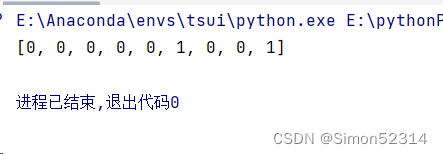LSTM ——作业
2023-12-17 18:37:03
习题6-4? 推导LSTM网络中参数的梯度, 并分析其避免梯度消失的效果
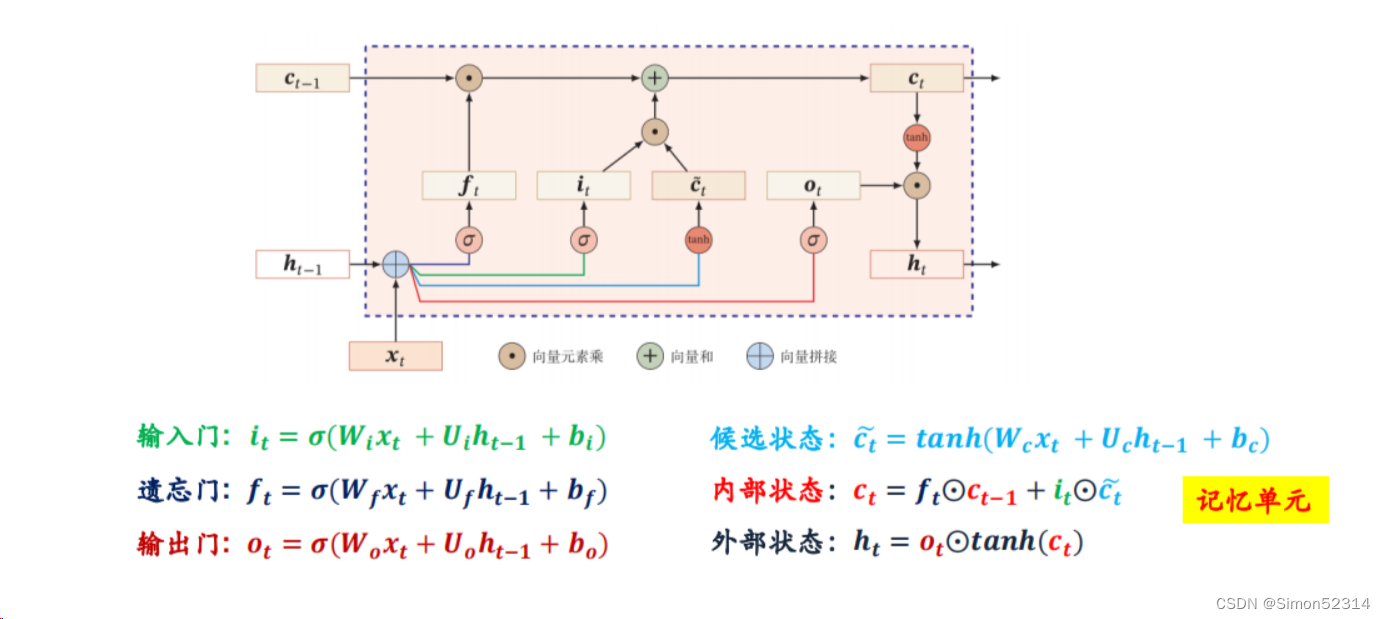
习题6-3P??编程实现下图LSTM运行过程?
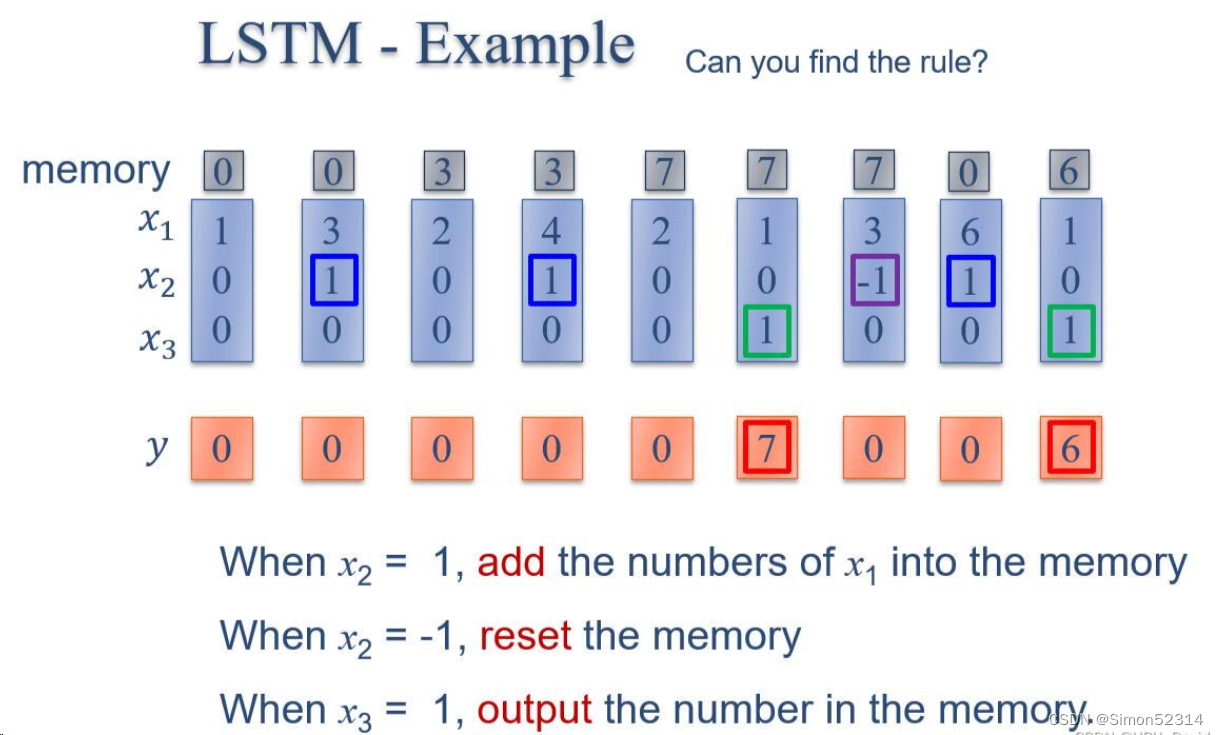
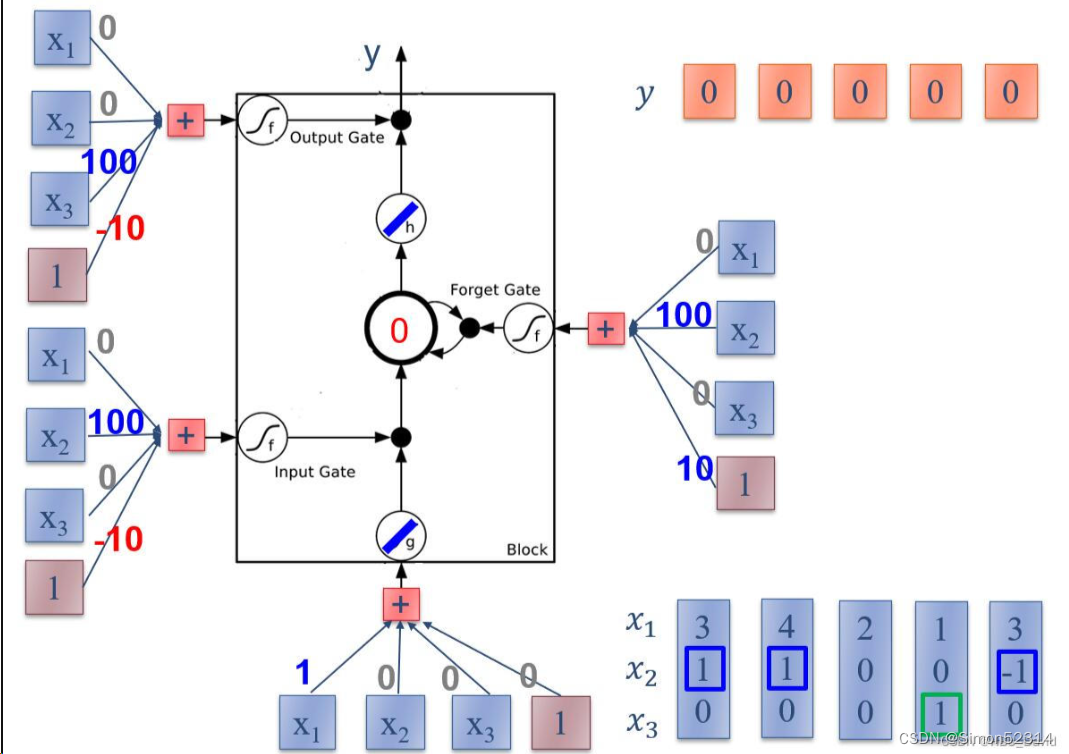
?1. 使用Numpy实现LSTM算子
import numpy as np # 创建一个numpy数组x,它是一个4x4的矩阵,包含9个元素 x = np.array([[1, 0, 0, 1], [3, 1, 0, 1], [2, 0, 0, 1], [4, 1, 0, 1], [2, 0, 0, 1], [1, 0, 1, 1], [3, -1, 0, 1], [6, 1, 0, 1], [1, 0, 1, 1]]) # 创建i_w数组,它是一个权重向量,用于计算输入门 i_w = np.array([0, 100, 0, -10]) # 创建o_w数组,它是一个权重向量,用于计算输出门 o_w = np.array([0, 0, 100, -10]) # 创建f_w数组,它是一个权重向量,用于计算忘记门 f_w = np.array([0, 100, 0, 10]) # 创建c_w数组,它是一个权重向量,用于计算候选细胞状态 c_w = np.array([1, 0, 0, 0]) # 定义sigmoid函数,它是一个激活函数,用于将输入映射到[0, 1]范围内 def sigmoid(x): y = 1 / (1 + np.exp(-x)) if y >= 0.5: return 1 else: return 0 # 初始化变量temp为0,它是用来存储临时结果的 temp = 0 # 初始化空列表y和c,分别用来存储每个时间步的输出和细胞状态 y = [] c = [] # 对于x中的每个元素i进行循环处理 for i in x: c.append(temp) # 将当前细胞状态添加到列表c中 temp_c = np.sum(np.multiply(i, c_w)) # 计算候选细胞状态,它是通过将输入i与权重向量c_w相乘然后求和得到的 temp_i = sigmoid(np.sum(np.multiply(i, i_w))) # 计算输入门,它是通过将输入i与权重向量i_w相乘然后求和,然后应用sigmoid函数得到的 temp_f = sigmoid(np.sum(np.multiply(i, f_w))) # 计算忘记门,它是通过将输入i与权重向量f_w相乘然后求和,然后应用sigmoid函数得到的 temp_o = sigmoid(np.sum(np.multiply(i, o_w))) # 计算输出门,它是通过将输入i与权重向量o_w相乘然后求和,然后应用sigmoid函数得到的 temp = temp_c * temp_i + temp_f * temp # 更新细胞状态,它是基于候选细胞状态、输入门和忘记门的计算结果得到的 y.append(temp_o * temp) # 计算LSTM的输出,它是基于输出门和新的细胞状态的乘积得到的,并将结果添加到列表y中 # 打印细胞状态列表c和输出列表y print("memory", c) print("y ", y)
这段代码参考了同学的代码,在这段代码中,我自己跟着敲了一遍,但是结果不对

经过自己勘察发现是激活函数那块代码写错了
?
?然后此外发现
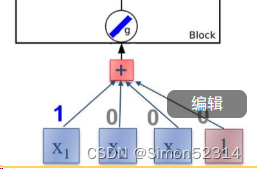 这一步有错误,没有经过tanh 的激活,于是添加代码
这一步有错误,没有经过tanh 的激活,于是添加代码
def tanh(x):
return np.tanh(x)并且 修改了一丢丢
temp = tanh(temp_c )* temp_i + temp_f * tempy.append(temp_o *np.tanh(temp))结果是这样的

再修改代码
# 打印细胞状态列表c和输出列表y print("memory", [round(cell) for cell in c]) print("y ", [round(output) for output in y])
2. 使用nn.LSTMCell实现?
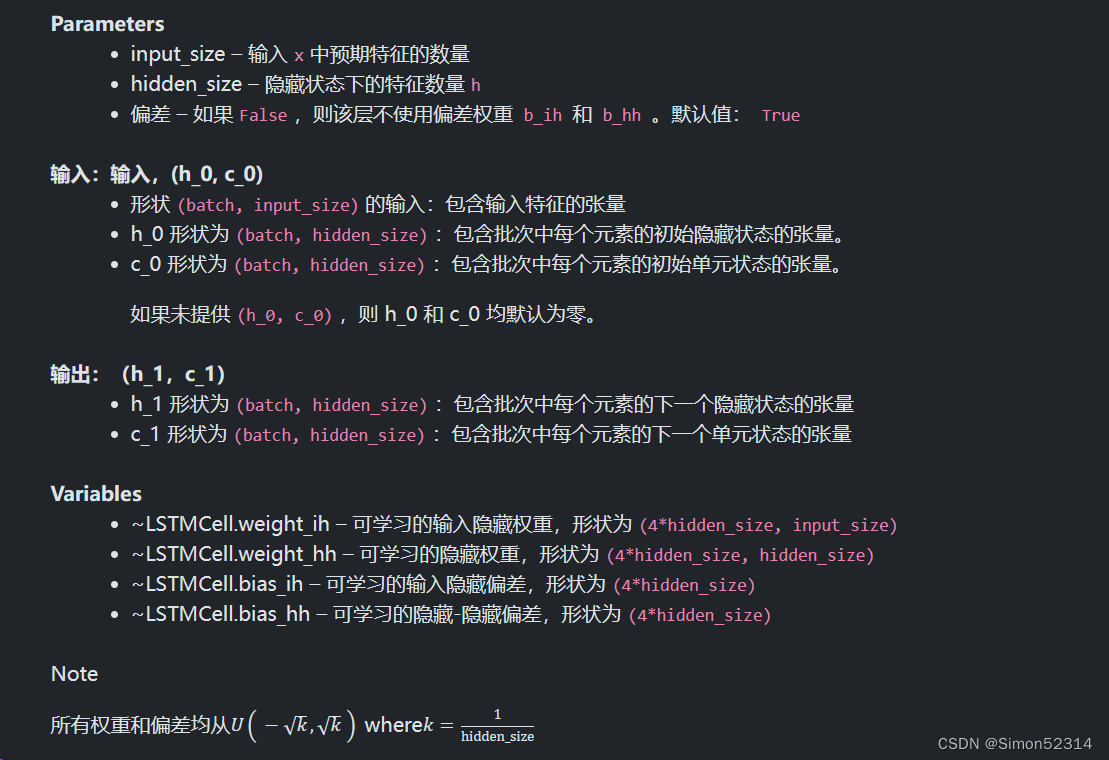
import torch import torch.nn as nn x = torch.tensor([[1, 0, 0, 1], [3, 1, 0, 1], [2, 0, 0, 1], [4, 1, 0, 1], [2, 0, 0, 1], [1, 0, 1, 1], [3, -1, 0, 1], [6, 1, 0, 1], [1, 0, 1, 1]], dtype=torch.float) # 在x的第二个维度上增加一个维度,这通常用于处理批次中的单个样本 x = x.unsqueeze(1) # 设置输入和隐藏状态的尺寸 i_size = 4 h_size = 1 # 创建一个LSTMCell,这是一个基本的LSTM单元,用于处理时间序列数据 lstm_cell = nn.LSTMCell(input_size=i_size, hidden_size=h_size, bias=False) # 为LSTM单元设置权重。这里的权重是硬编码的,通常这些权重是从训练过程中学习得到的。 lstm_cell.weight_ih.data = torch.tensor([[0, 100, 0, 10], [0, 100, 0, -10], [1, 0, 0, 0], [0, 0, 100, -10]]).float() # 设置隐层到隐层的权重,初始为零 lstm_cell.weight_hh.data = torch.zeros([4 * h_size, h_size]) # 初始化隐层和细胞状态为零张量 hx = torch.zeros(1, h_size) cx = torch.zeros(1, h_size) # 用于存储每个时间步的输出 outputs = [] # 在x的每个元素上运行LSTM单元 for i in range(len(x)): # 使用LSTM单元处理输入和当前状态,返回下一个隐层状态和细胞状态 hx, cx = lstm_cell(x[i], (hx, cx)) # 将输出添加到outputs列表中 outputs.append(hx.detach().numpy()[0][0]) # 将outputs列表中的每个元素四舍五入到最近的整数,并存储到新的列表中 outputs_rounded = [round(x) for x in outputs] # 打印四舍五入后的输出列表 print(outputs_rounded)
结果一致,所以答案正确。??
3. 使用nn.LSTM实现
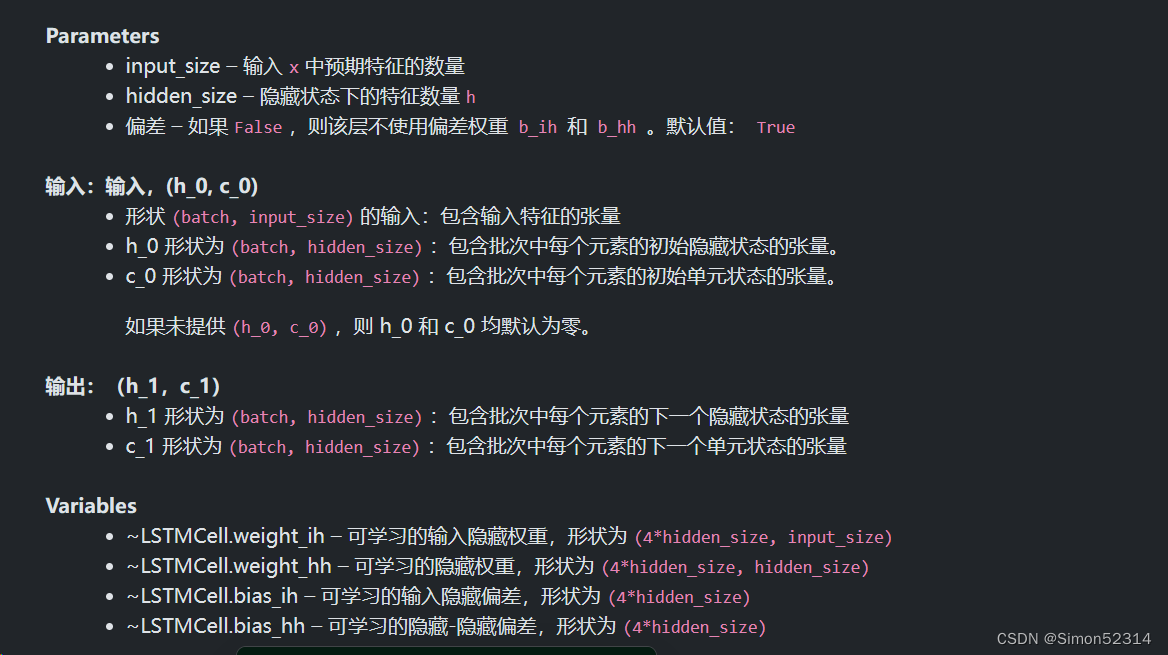
import torch import torch.nn as nn x = torch.tensor([[1, 0, 0, 1], [3, 1, 0, 1], [2, 0, 0, 1], [4, 1, 0, 1], [2, 0, 0, 1], [1, 0, 1, 1], [3, -1, 0, 1], [6, 1, 0, 1], [1, 0, 1, 1]], dtype=torch.float) # 在x的第二个维度上增加一个维度,这通常用于处理批次中的单个样本 x = x.unsqueeze(1) # 设置输入和隐藏状态的尺寸 i_size = 4 h_size = 1 # 创建一个LSTMCell,这是一个基本的LSTM单元,用于处理时间序列数据 lstm= nn.LSTM(input_size=i_size, hidden_size=h_size, bias=False) # 为LSTM单元设置权重。这里的权重是硬编码的,通常这些权重是从训练过程中学习得到的。 # 设置 LSTM 的权重矩阵 lstm.weight_ih_l0.data = torch.tensor([[0, 100, 0, 10], [0, 100, 0, -10], [1, 0, 0, 0], [0, 0, 100, -10]]).float() # 设置隐层到隐层的权重,初始为零 lstm.weight_hh_l0.data = torch.zeros([4 * h_size, h_size]) # 初始化隐层和细胞状态为零张量 hx = torch.zeros(1,1, h_size) cx = torch.zeros(1,1, h_size) # 前向传播 outputs, (hx, cx) = lstm(x, (hx, cx)) outputs = outputs.squeeze().tolist() # 将outputs列表中的每个元素四舍五入到最近的整数,并存储到新的列表中 outputs_rounded = [round(x) for x in outputs] # 打印四舍五入后的输出列表 print(outputs_rounded)
总结:
?1、推导还是那样先把流程中用到的所有式子写出来,然后倒着找相关的往后推导
2、代码看的熬夜患者的,跟着打了一遍,其实第二个第三个很相似,3使用了封装的nn.LSTM来定义和计算LSTM模型的前向传播,而2代码使用nn.LSTMCell来手动计算LSTM的前向传播。
参考链接:
PyTorch - torch.nn.LSTMCell (runebook.dev)
【23-24 秋学期】NNDL 作业11 LSTM-CSDN博客
? ? ? ? ? ? ? ? ? ? ? ? ? ? ? ? ? ? ? ? ? ? ? ? ? ? ? ?
?
文章来源:https://blog.csdn.net/m0_62581697/article/details/135001307
本文来自互联网用户投稿,该文观点仅代表作者本人,不代表本站立场。本站仅提供信息存储空间服务,不拥有所有权,不承担相关法律责任。 如若内容造成侵权/违法违规/事实不符,请联系我的编程经验分享网邮箱:veading@qq.com进行投诉反馈,一经查实,立即删除!
本文来自互联网用户投稿,该文观点仅代表作者本人,不代表本站立场。本站仅提供信息存储空间服务,不拥有所有权,不承担相关法律责任。 如若内容造成侵权/违法违规/事实不符,请联系我的编程经验分享网邮箱:veading@qq.com进行投诉反馈,一经查实,立即删除!



